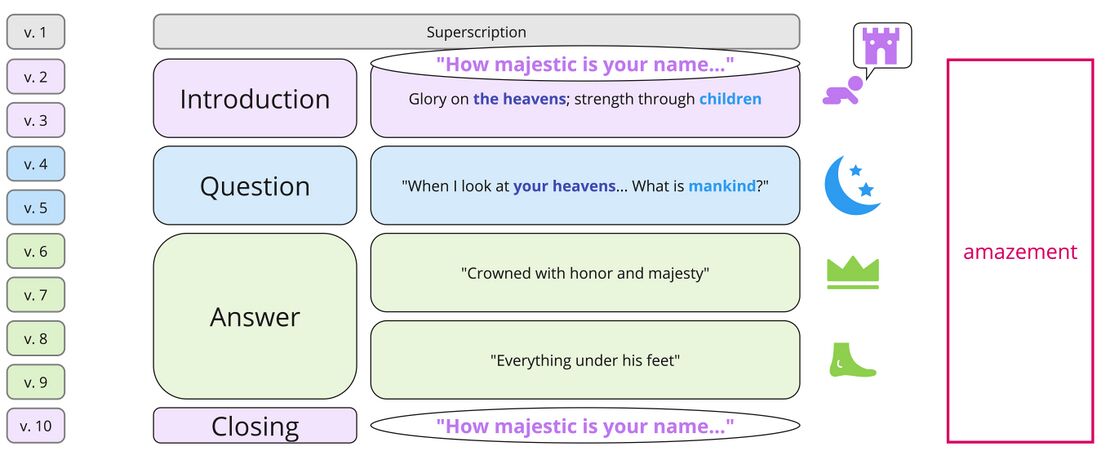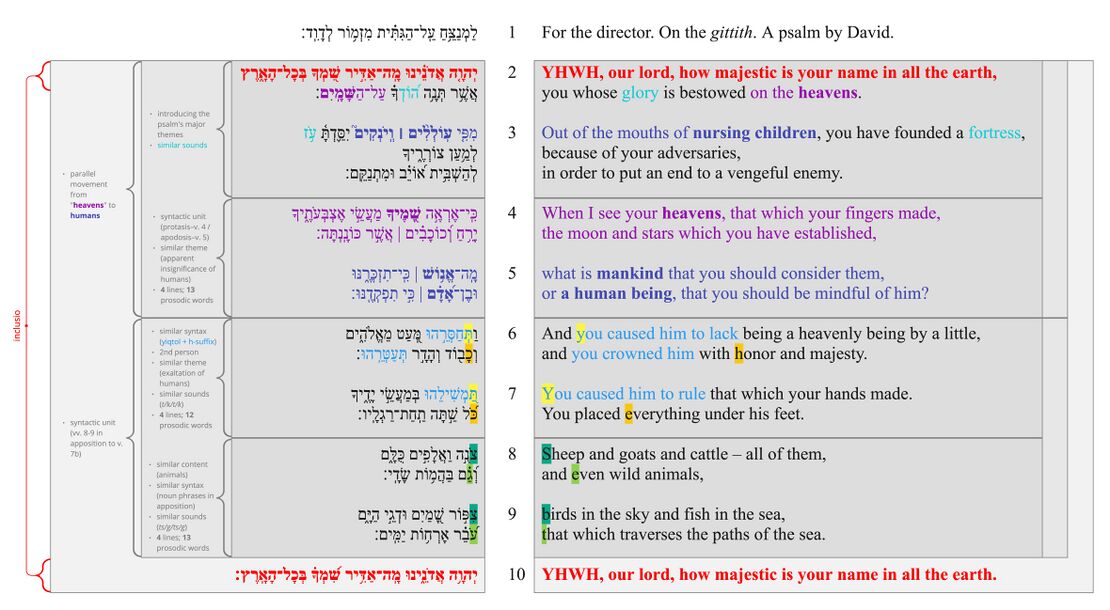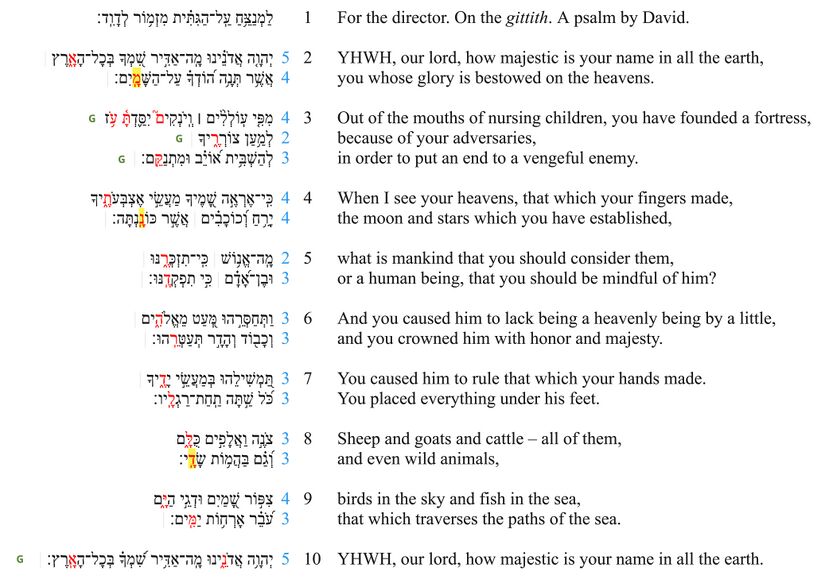Psalm 8 Poetic Structure
Poetic Structure
In poetic structure, we analyse the structure of the psalm beginning at the most basic level of the structure: the line (also known as the “colon” or “hemistich”). Then, based on the perception of patterned similarities (and on the assumption that the whole psalm is structured hierarchically), we argue for the grouping of lines into verses, verses into sub-sections, sub-sections into larger sections, etc. Because patterned similarities might be of various kinds (syntactic, semantic, pragmatic, sonic) the analysis of poetic structure draws on all of the previous layers (especially the Discourse layer).
Poetic Macro-structure
If an emendation or revocalization is preferred, that emendation or revocalization will be marked in the Hebrew text of all the visuals.
| Emendations/Revocalizations legend | |
|---|---|
| *Emended text* | Emended text, text in which the consonants differ from the consonants of the Masoretic text, is indicated by blue asterisks on either side of the emendation. |
| *Revocalized text* | Revocalized text, text in which only the vowels differ from the vowels of the Masoretic text, is indicated by purple asterisks on either side of the revocalization. |
Notes
- vv. 2a, 10. The psalm is bound by an inclusio (cf. the inclusio in Ps 103).
- vv. 2b-3. Verse 2b is connected both to the previous line and to the following lines. As Waltke writes, "Verse 2b is a janus. It is linked to the superscript 2a by an exceptional relative 'who,' by the Masoretic accents that retain the earliest known interpretation of the psalm, and by this parallelism: (A) I AM (B) how majestic is your name (C) in all the earth // (A') You who (B') place your splendor (C') upon the heavens."[1] There are also sound correspondences that join v. 2b and v. 2a (shamayim // shimka; tenah // mah; adir // hod). At the same time, v. 2b is connected to the body of the psalm, introducing the theme of glory on the heavens (cf. v. 4f) and the point of departure for the vertical descent that runs throughout the rest of the psalm ("on/above the heavens", see poetic feature #2).
- vv. 4-5. Verses 4-5 are bound together as a single syntactic unit; v. 4 is the protasis ("when..."), and v. 5 is the apodosis ("then..."). These two verses share a similar theme: the apparent insignificance of humanity (v. 5) compared with the heavens (v. 4). This section is parallel to the previous section; both move from the heavens above (v. 2b // v. 4) to weak humanity below (v. 3 // v. 5).
- vv. 6-7. Verses 6-7 are bound together by similar syntax (the use of 2ms yiqtol verbs with he suffixes), a similar theme (the exaltation of humans), and the alternating sequence of lines that begin with tav and kaf. Some see a chiasm in the verb forms.
- vv. 8-9. Verses 8-9 are bound together by similar syntax (appositional noun phrases), similar content (animals), and an alternating sequence of lines that begin with ts and g.[2]
The first half of Psalm 8 ends with a rhetorical question (v. 5) which is then answered in the second half of the psalm (vv. 6-9). Cf. Ps 11.
Line Divisions
Line division divides the poem into lines and line groupings. We determine line divisions based on a combination of external evidence (Masoretic accents, pausal forms, manuscripts) and internal evidence (syntax, prosodic word counting and patterned relation to other lines). Moreover, we indicate line-groupings by using additional spacing.
When line divisions are uncertain, we consult some of the many psalms manuscripts which lay out the text in lines. Then, if a division attested in one of these manuscripts/versions influences our decision to divide the text at a certain point, we place a green symbol (G, DSS, or MT) to the left of the line in question.
| Poetic line division legend | |
|---|---|
| Pausal form | Pausal forms are highlighted in yellow. |
| Accent which typically corresponds to line division | Accents which typically correspond to line divisions are indicated by red text. |
| | | Clause boundaries are indicated by a light gray vertical line in between clauses. |
| G | Line divisions that follow Greek manuscripts are indicated by a bold green G. |
| DSS | Line divisions that follow the Dead Sea Scrolls are indicated by a bold green DSS. |
| M | Line divisions that follow Masoretic manuscripts are indicated by a bold green M. |
| Number of prosodic words | The number of prosodic words are indicated in blue text. |
| Prosodic words greater than 5 | The number of prosodic words if greater than 5 is indicated by bold blue text. |
If an emendation or revocalization is preferred, that emendation or revocalization will be marked in the Hebrew text of all the visuals.
| Emendations/Revocalizations legend | |
|---|---|
| *Emended text* | Emended text, text in which the consonants differ from the consonants of the Masoretic text, is indicated by blue asterisks on either side of the emendation. |
| *Revocalized text* | Revocalized text, text in which only the vowels differ from the vowels of the Masoretic text, is indicated by purple asterisks on either side of the revocalization. |
Notes
- vv. 2-3. The line division of vv. 2-3 is difficult. In the visual above, v. 2b is taken as a verse together with v. 2a, and the phrase מִפִּ֤י עֽוֹלְלִ֨ים ׀ וְֽיֹנְקִים֮ is grouped with what follows rather than what precedes. This division follows the traditional interpretation of the Masoretic accents which is supported also by the ancient versions (LXX [cf. Matt. 21:16], Jerome, Peshitta, Targum). See [1].
- v. 3. No division is made at the sinnor in v. 3, since this would leave יִסַּ֪דְתָּ֫ עֹ֥ז on its own line, and lines do not usually have one prosodic word.[3]




